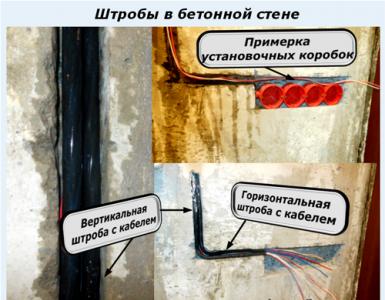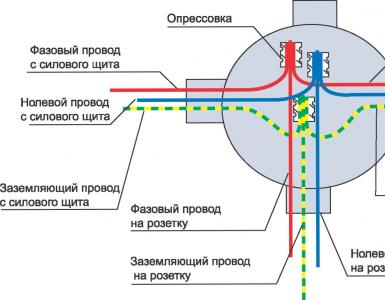How pipes are laid using the puncture method: technical rules and expert advice
When underground utilities cross a road or railroad, the dismantling of such facilities can be extremely difficult, and often even impossible. Pipe laying by puncture method will help to solve the problem. This method does not require large expenditures and is performed using special equipment.
The puncture method is a technology in which it is possible to obtain a hole without excavation and excavation by compacting it. This method is suitable for laying steel structures. The diameter can vary within 100-500 mm, the length of the hole is 30-50 m. A puncture under the road is one of the most popular methods of trenchless laying of communications.
A controlled puncture is used for laying:
- communications made of metal and plastic;
- cases, in which gas and water pipes are then laid;
- cases for power, telephone cables, etc.
The puncture is used not only in cases where it is necessary to cross the highway or railway tracks painlessly. The method is suitable for laying holes in a well (provided that the diameter of this well is at least one and a half meters), the basement of a house, if necessary, to lay wires under some relatively small object, etc.
Controlled puncture is one of the least expensive ways of trenchless laying of communications under the road or other similar objects (+)
Most often, a controlled puncture is performed in the thickness of clay soil under various roads, for example, under a highway or a railway track. For this, a pumping and jacking pressure unit is used, for example, such as the Ditch Witch P80 installation. In addition, you will need a set of expanders, rods, heads and other tools with which drilling is performed.
Be sure to use a hydraulic station. The necessary force effect is provided by a hydraulic cylinder, the acceptable power of the unit is about 36 tons. The work of the station must be provided by an internal combustion engine. To monitor the progress of work in the thickness of the soil, wireless location tools are used.
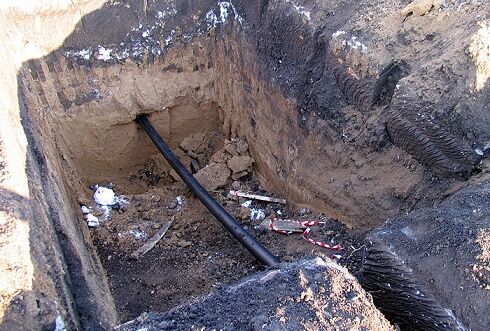
To perform trenchless pipe laying using the puncture method, it is necessary to first make two pits: starting and finishing (or receiving)
As an example, consider the operation of the Eclipse location device. A probe is placed in the drill head, which transmits information about the progress of drilling operations. The information is sent to the locator. Here, the data is analyzed, as a result of which the exact location of the drilling tool in the soil, the angle of inclination of the drill head, and the correspondence of its movement to the previously drawn up work plan are determined. At the same time, the state of the battery of the probe from which information is received is monitored.
The drill head is designed in such a way that part of its surface is bevelled. This improves productivity, but affects the quality of work. Due to the bevel, when advancing in the thickness of the soil, the position of the head will constantly deviate from the impact vector. The operator must constantly correct the trajectory of the movement of the head, referring to the location results.
In order for the tool to move strictly in a straight line, it must be rotated at a constant speed. The first stage of the puncture is started in the starting pit, and completed in the receiving pit. Here, instead of the drill head, a cone expander is fixed to the installation. This device passes the formed horizontal well in the opposite direction, which allows it to be expanded and the walls to be compacted.
After that, a pipe of the required diameter or a case for laying communications is inserted into the resulting long hole. Depending on the situation, you can lay not one, but several pipes. Further actions are to lay these communications and connect them to the common system.
During the preparatory work, it is also necessary to consider the location of the pipes, which should be located near the drilling site. Usually, a pipe site is provided next to the starting pit. The dimensions of the storage area depend on the length of the pipes, which can be up to six meters.
The pipes should preferably be stored in a horizontal position. This will simplify installation and reduce the likelihood of damage to the structure. In addition, it is necessary to provide access roads to the starting pit in order to freely deliver materials and the equipment necessary for the work.

The controlled puncture method allows you to successfully lay both plastic and metal pipes in the thickness of the soil. First, a pilot puncture is performed, then compaction is carried out in the opposite direction.
First, a preliminary survey of the work site is carried out on the ground. At the same time, specialists use project documentation, based on which, as well as on the results of the analysis of the object, a puncture execution plan is drawn up. If it is necessary to perform a puncture under an object experiencing serious traffic loads (tram tracks, highways, railways, subways, etc.), the pipes are laid in special cases.
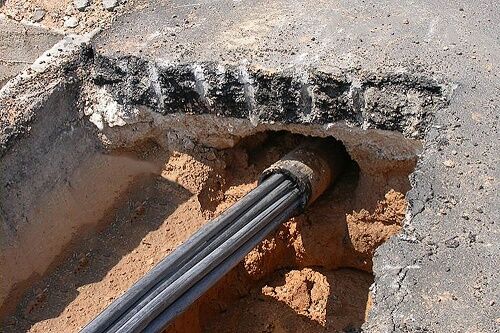
If you need to lay several cables under the road, first lay a pipe or case, the diameter of which allows you to accommodate all the necessary communications
Such a case should have a diameter exceeding the dimensions of the pipes by about 15-20 cm. First, a case is placed, then pipes are mounted in it, and the space between these communications is filled with a solution for which inexpensive M-100 cement can be used. Cases reduce the load on underground utilities and reduce the risk of damage.
Hydro-, vibropuncture and punching
There are hydro and vibropunctures. In the first case, a water jet is used as a tool for punching the soil, which, under high pressure, beats from a special tip. This method is especially effective on non-cohesive sandy soils that are easily eroded by the action of the jet. It allows you to make a hole with a diameter of about 50 cm in a minimum amount of time. But the maximum length of the well with a hydraulic puncture is 30 m.
Vibropuncture, as the name implies, is carried out with the help of vibration exposure. In the device for puncture, shock-vibration-pressing installations with exciters of longitudinally directed vibrations are used. Static indentation is combined with the impact on the soil of the shock pulses of the vibratory hammer. The method is used on quicksand and sandy soils for both laying pipes and extracting them. The borehole can be up to 50 cm in diameter and 60 m long.
The punching method is carried out using jacks, like a puncture. But in this case, the pipe is directed to the ground with an open end. In the process of advancing the structure, a dense cork from the soil is formed in the pipe, which is then removed. To perform this type of work, from two to eight powerful (for 200-400 tons) hydraulic jacks are used, for the operation of which it is necessary to install a thrust wall with a frame and a cap.
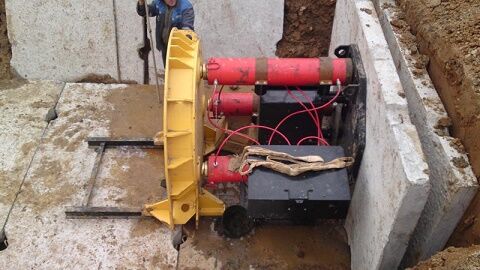
Ground jacking is a trenchless pipe-laying method that is carried out using special high-powered hydraulic rigs.
During a shift, such a device can pass up to 10 meters of soil, and the total length of the well usually does not exceed 80 meters. If it is required to lay a longer route, it is divided into separate sections of no more than 80 meters. This method also requires the device of the initial and final pit, in which the necessary hydraulics are installed.
The penetration of each section is performed twice: in the forward and then in the opposite direction. The control of the operation of the mechanisms and the quality of punching is carried out by the operator, who is in the pit.
Technically, this method is more complicated than a conventional puncture, but it can be used on almost any soil. The diameter of the structure can reach 172 cm. The development of the core formed inside the pipe can be done manually or by mechanized means.
Advantages of the puncture method
The demand for the puncture method is due to its significant advantages compared to other options for performing work of this type. For example, a puncture is available at any time of the year; high or low temperatures of the outdoor air and soil do not matter much.
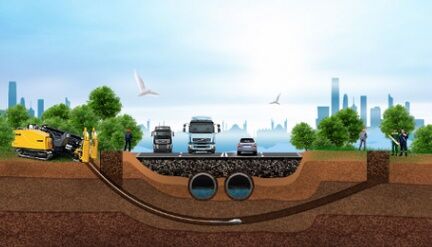
One of the advantages of the controlled puncture method is that work can also be carried out in areas with elevated groundwater levels.
The operation of the installation does not require the use of bentonite slurry, the supply of water or drilling fluid to the well. This is a compact and powerful unit, which is equipped with a reliable electrical safety system. It is not difficult to deliver to the object and install. At the same time, the compact size does not prevent the device from working with high power rates.

Trenchless pipe laying methods, such as controlled puncture, can be successfully applied in both summer and winter.
The turnaround time is also shorter than with other methods. Even if there is an increased level of groundwater at the site where the puncture is performed, there is no need to carry out measures to divert water from the site. During the passage of the expansion cone, the walls of the trench are also compacted, so no additional work is required in this regard.
Performing a puncture on different objects
The complexity and speed of this type of work largely depends on the conditions, i.e. on the terrain and characteristics of the object under which the puncture is performed. Drilling under a railroad track usually requires a fairly serious design. First you need to coordinate drilling with a number of railway services.
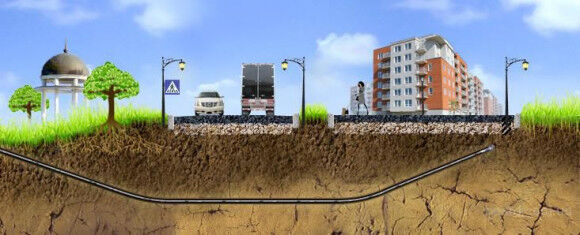
The use of the controlled puncture method within the city limits preserves the integrity of the road routes in order to minimize costs and not disrupt traffic
In Russia, you need to contact the divisions of the ECH, ShCh, RCS NODG, PC and other services of Russian Railways. It is mandatory to draw up contracts for technical supervision, as well as for the installation of insurance packages. All as-built documentation must be agreed upon and provided to the railway authorities.
A package of documents is transferred to the distance of the path at the end of the cycle of work on laying pipes. In cities, a puncture under the road is in great demand when laying new communications, especially in places with historical sights. The method allows not only to maintain normal traffic on the roads, but also to prevent the destruction of the old pavement when it is necessary to lay pipes under such sections.
Restoring such an object can be difficult, and sometimes impossible. In cottage settlements, the laying of communications by the puncture method allows you to perform all the work with minimal damage to ready-made objects: roads, fences, etc.
What are the alternatives?
In addition to the controlled puncture method, there are other options for arranging communications in the thickness of the soil without trenching. Sometimes an alternative may be more acceptable than a puncture, it all depends on the specific situation. Horizontal directional drilling, which is also called directional drilling, is used for laying pressure and non-pressure pipelines.
Drilling in this way is carried out from the surface of the earth. The diameter of the hole should be taken 30-50% larger than the dimensions of the pipes that are supposed to be laid in it. The hole is not expanded immediately, but in several stages. In this case, a bentonite solution is used, which is mixed with loosened soil and facilitates its removal from the trunk.
In addition, this working fluid is used to cool the drilling tool, and later it forms a layer on the walls of the mine, which protects them from destruction. An sludge pump is used to pump out the spent bentonite solution. After pumping, the waste solution must be taken to a landfill for further disposal.
If the work is done correctly, the result is a clean well with strong walls. Drilling rigs for this type of work have different characteristics, such as torque and traction. The length of the pipes that will be laid in the thickness of the soil, which can reach 1000 meters, depends on this.
The allowable pipe diameter is 120 cm. Both metal and plastic pipes can be laid by horizontal directional drilling. Drilling is carried out along a pre-calculated trajectory, the movement of the drilling tool is controlled by a location system. The drilling angle can vary between 26-34 degrees. Another important indicator when using HDD is the bending of the rods, which can be 6-12%, depending on their type.
Another popular method of trenchless pipe laying is auger drilling. For its implementation, a special hydraulic installation is used, acting as a jack. First, start and finish pits are made. The depth of each of them should be one meter deeper than the level of the pipeline.
A hydraulic unit is lowered into the starting pit, which rotates the auger and the punching pipes. As a result, part of the soil is removed and a well for the pipe is obtained. Then pipes, cases, etc. are installed inside. The maximum laying length is usually only 100 meters, but the diameter of communications can reach 172 cm, the indicators largely depend on the type of soil on which drilling is carried out.

The method of punching steel cases is often used if it is necessary to lay pipes or cases of large diameter using trenchless methods.
To control the work during auger drilling, a laser is used, which provides the correct angle of inclination of the drill, and also allows you to track the direction of drilling with high accuracy. After the auger reaches the finish pit, it is removed from the resulting well in the reverse order.
Microtunneling is a high-precision method of trenchless laying of communications, which is performed using a special tunneling shield. A high power jacking station is used to move the device. It affects a column of reinforced concrete pipes that are attached to the shield. Gradually, the length of the well increases, so the length of the column is increased by building up reinforced concrete structures.
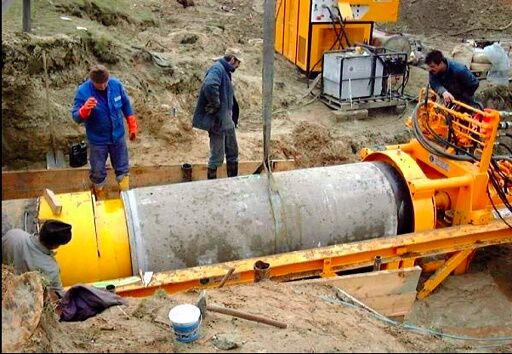
For laying reinforced concrete and steel pipes, the microtunneling method is used. It is performed using a special tunneling shield that loosens the soil
This method also requires the preliminary preparation of two pits, the distance between them can vary between 50-500 meters. The jacking installation must be lowered into the starting pit to a depth that corresponds to the level of laying communications. If the well length exceeds 200 meters, an intermediate jacking station is usually used.
The tunneling shield loosens the soil, which is washed out with water or bentonite solution coming through the supply lines. Waste liquid, mixed with soil particles, moves to the sump along the discharge lines. After the tunneling shield enters the finishing pit, the work can be considered completed.
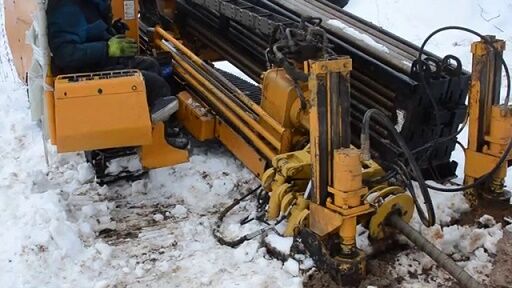
Trenchless methods of laying communications are carried out using special high-power equipment. Accurate adherence to technology will ensure a reliable well
The equipment is dismantled and removed. Microtunnelling can be used to install not only reinforced concrete, but also steel pipes. To control the correctness of the work, a navigation system is used, consisting of a laser, a target and a measuring wheel. For long sections (more than 200 m), an electronic laser system equipped with a hydrostatic level is considered effective, which gives accurate information about the depth of pipe laying, regardless of the air temperature inside the structure.
How to choose the right way
The method of laying communications using horizontal drilling is chosen at the stage of designing a specific process. If trenchless pipe laying will be carried out as part of the construction of an object, for example, a residential building, then the work may become part of the overall construction project. When designing, the following information is taken into account:
- the length of communications that need to be laid in a trenchless way;
- case or pipe diameter;
- the material from which communications are made;
- the depth to which the pipes must be laid;
- type of pipeline (pressure or non-pressure);
- the ability to install the starting and finishing pits of suitable depth;
- access roads to the place of work;
- the presence of a sufficiently spacious area for storing materials, equipment, etc.;
- groundwater level;
- other geological features of the site;
- plan for the location of communications already existing on the site.
During the construction process, it is sometimes necessary to change an already drawn up project. This may be due to the desire to cut costs by using, for example, plastic pipes instead of steel ones. In addition, the plan for the location of underground utilities at the facility is not always accurate enough.
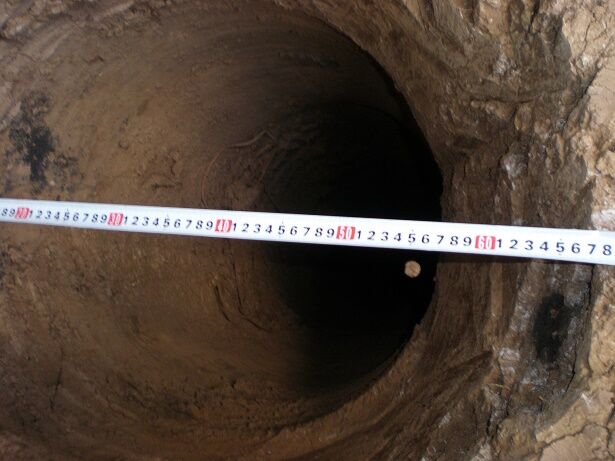
Pipe diameter is one of the indicators that are taken into account when choosing methods for trenchless laying of communications. The well should be a little bigger
When performing work, such unaccounted pipes or cables may be found. All these points may require changes in the project, and this may affect the decision on the method of drilling. If the depth of laying communications is small, there is a danger of subsidence of the top layer of soil, especially if a bentonite solution was used during drilling. In such cases, it is better to give preference to horizontal auger drilling.
Very often, the drilling method is determined by what kind of equipment is available to the organization fulfilling the order. For example, if builders have jacks or a horizontal directional drilling rig, then this will be given preference over the puncture method. Most often, such changes are dictated by considerations of economic benefits.
Guided Puncture Video
Visually, the process of operation of the installation for performing a controlled puncture is presented here:
Controlled puncture is a highly accurate and relatively inexpensive way to lay communications under a road or other object. At the same time, it is important to correctly design all work and strictly follow the technology.


